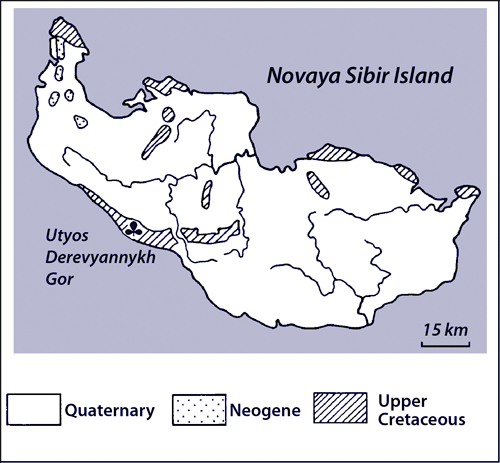Novaya Sibir' Island
| Introduction | Novaya Sibir' | Kotyl'nyi | NE Russia Map |
|---|
Terrigenous and volcaniclastic continental deposits with coal and coaly clay beds belonging to the Derevyannye Gory formation are exposed in "Utyos Derevyannykh Gor" (Derevyannye Mountains Cliff) (75°01′05.6′′ N, 147°05′46.6′′ E) on the southern coast of the Novaya Sibir' Island (see map to the right). This succession contains rich and diverse plant fossils. The Novaya Sibir' flora is the northernmost Late Cretaceous flora found to- date. Usually plant material from the Cretaceous of Arctic Russia lacks cuticles. However plant fossils from this locality are represented by both impressions and mummified leaves and shoots with well preserved cuticles. These plant fossils were studied by Schmalhausen (1890) (fossils collected by Toll in 1885 - 1886), Vassilevskaya (1958) (a small collection made by Ivanov in 1955), Sveshnikova and Budantsev (1969), who collected plant material in 1961 during reconnaissance work on the Novaya Sibir' Island, and Herman (1994), who studied plant fossils collected by G. Ivanenko in 1990. The fossil material so far examined by A.B. Herman comes from three flora-bearing beds within the Derevyannye Gory formation. They reveal 14 plant species: Asplenium dicksonianum Heer, Cladophlebis sp. 1, Cladophlebis sp. 2, Ginkgo ex gr. pilifera Samyl., Desmiophyllum sp., Pityophyllum ex gr. nordenskioldii (Heer) Nath., P. staratschinii (Heer) Nath., Pityostrobus sp., Sequoia tenuifolia (Schmalh.) Sveshn. et Budantsev, Parataxodium ex gr. neosibiricum Sveshn. et Budantsev, ?Tollia ex gr. cunninghamoides Sveshn. et Budantsev, Libocedrus arctica Sveshn. et Budantsev, Trochodendroides ex gr. arctica (Heer) Berry, Pseudoprotophyllum boreale (Daws.) Hollick. Parataxodium ex gr. neosibiricum and Sequoia tenuifolia are the most abundant among them. The collection also includes fossil woods and leaf fragments of platanoids and Cissites (?). The following list of plant fossils representing the complete flora insofar as it is known is based on Schmalhausen (1890), Vassilevskaya (1958), Sveshnikova and Budantsev (1969), Budantsev (1983) and Herman (1994): Polypodiopsida: Asplenium dicksonianum Heer, Hausmannia nansenii Budants. et Sveshnikova, Cladophlebis meyerii (Heer) Vassilevsk., Cladophlebis sp. 1, Cladophlebis sp. 2. Ginkgoales: Sphenobaiera sp., Torellia sp., Ginkgo ex gr. adiantoides (Ung.) Heer, G. ex gr. obrutschewii Sew., G. ex gr. pilifera Samyl. Pinophyta incertae sedis: Desmiophyllum sp., Pinales: Podozamites sp., Agathis tollii Schmalh., Cephalotaxopsis heterophylla Hollick, Cedrus lopatinii Heer, Pseudolarix schmalhausenii Sveshn. et Budantsev, Pityophyllum ex gr. nordenskioldii (Heer) Nath., P. ex gr. staratschinii (Heer) Nath., Pityostrobus sp. 1-2, Pityolepis sp. 1-2, Pityospermum sp. 1-2, Sequoia tenuifolia (Schmalh.) Sveshn. et Budantsev, Parataxodium neosibiricum Sveshn. et Budantsev, P. ex gr. neosibiricum Sveshn. et Budantsev, Taiwania microphylla Sveshn., Tollia cunninghamoides Sveshn. et Budantsev, T. ex gr. cunninghamoides Sveshn. et Budantsev, Libocedrus arctica Sveshn. et Budantsev, Thuja cretacea (Heer) Newberry, Angiosperms: Trochodendroides arctica (Heer) Berry, T. ex gr. arctica (Heer) Berry, T. smilacifolia (Newb.) Krysht., T. richardsonii (Heer) Krysht., Platanus sp., Credneria (= Arthollia) sp., Pseudoprotophyllum boreale (Daws.) Hollick, P. giganteum Budants. et Sveshnikova, P. parvaefolium Budants. et Sveshnikova, Pseudoprotophyllum sp. 1-2, “Acer” quercifolium (Hollick) Baik., Hedera gracile Budants. et Sveshnikova, Zizyphoides varietas (Hollick) Budants., Z. smilacifolia Budants., Cissites sp. cf. Dalembia comparabilis (Hollick) Lebedev et Herman, Cissites sp., Viburnum sp., Macclintockia decurrens Budants. et Sveshnikova, M. neosibirica Budants. et Sveshnikova, together with fossil wood, accumulations of leaf cuticles and seeds. This composition implies that the age of the flora-bearing deposits should be estimated as Turonian, and this is corroborated by palynologic data (Budantsev, 1983; Bondarenko, 1983). |
Map of Novaya Sibir' Island showing the position of the Utyos Derevyannykh locality.
Section at the Utyos Derevyannykh locality, Novaya Sibir' Island. |
|
 |
||
| A composite panorama of the Utyos Derevyannykh Gor site on Novaya Sibir' Island, Arctic Russia. | ||


